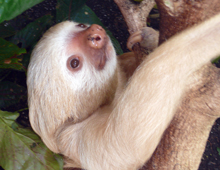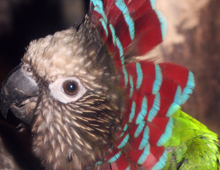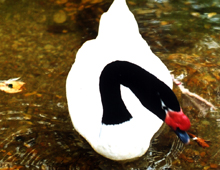The Jungle

Hoffman’s two-toed sloth, Choloepus hoffmanni
The two species of Choloepus (two-toed sloth) have two toes on their forelimbs, and three on their hind limbs. While the gentle Bradypus (three-toed sloth) eats only leaves of a few tree species, and are notoriously difficult to maintain in zoos, captive Choloepus enthusiastically eat all sorts of vegetables, as well as leaf-eater primate chow, and easily live for decades in captivity. Of the two species of Choloepus, both are found in South America, but only Hoffman’s occurs in Central America as well.
LEARN MORE
Hawk-headed parrot, Deroptyus accipitrinus
In most classification systems, this northern South American bird is considered one of the most evolved of the 368 species of parrots throughout the world. It has a unique set of elongated red and blue feathers on the back of its head that can be raised into a head-dress like structure, so that another common name is “Red fan parrot”. Until the 1970s it was very rare in zoos, but is now frequently bred, including at the DWA.
LEARN MORE
Curl-crested aracari, Pteroglossus beauharnaesii
This elegant bird is unique among toucans for having a cap of tightly curled feathers that appear “permed”. While not a rare bird in its range (south of the Amazon, divided among Peru, Bolivia, and Amazonian Brazil), it was almost unknown in captivity before the 1960s, and has never been common in zoos. The Curl-crested aracari was not bred in captivity until 1996. The DWA has had immense success propagating this species, with more than 100 birds since 2006.
LEARN MORE
Black-necked swan, Cygnus melanocoryphus
This magnificent bird was first bred in captivity, in Europe, more than 160 years ago, and his been highly prized in zoos and important private collections ever since. Found in southern South America and the Falkland Islands, it occurs in both fresh and salt water. Breeding pairs are devoted parents and carry their growing young on their back, almost sinking under their weight.
LEARN MORE
White-faced saki, Pithecia pithecia
Before the 1970s, this Northern South American monkey was very rare in captivity, but an improved understanding of its diet and health have led to this species being bred frequently, so that it is now one of the most widely-kept New World primates in American zoos. This is one of a relatively small number of primates where the sexes are easily told by their color; males are black with white faces, while females are grayish with a whitish line on either side of the muzzle.
LEARN MORE
Toco toucan, Ramphastos toco
Dwelling on the edges of forests, along rivers, and where trees are present in savannahs, this huge toucan is the only member of its family commonly found in open country. It inhabits an enormous range, all the way from the Guianas to Northern Argentina. It is the largest and best known of the toucan species and includes grunts in its vocalizations. Over 100 have been hatched in more than a dozen US collections (including the DWA), as part of a coordinated breeding program during the last quarter century.
LEARN MORE

